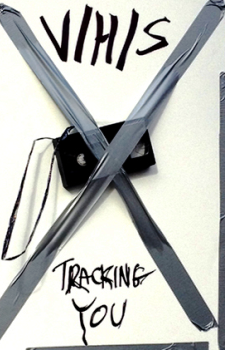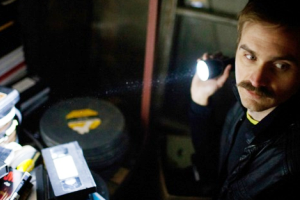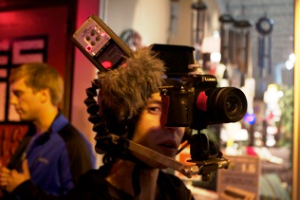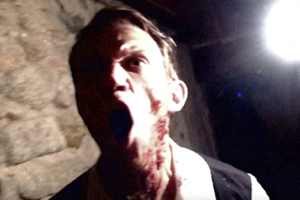
After attending the screening of V/H/S at the Atlanta Film Festival I had attempted to stay away from reading anything about the film before viewing it and barely knew the plot. To be honest, I am very tired of the lazy found footage films, and think that most of the filmmakers that use this method to be tripe and just using the found footage to avoid struggling through traditional story methods. Horror films seem to abusing the found footage more than any other genre, so imagine my surprise when I walked out of this film thinking it was one of the best films I have witnessed so far this year (right up there with Chronicle and The Grey). The one thing I will amend my found footage statement with is the use of special effects to take it past the normal excuse of boring jump sequences or the Paranormal Activitiy laziness of just showing some things moving for most the film (I guess that is the only way to explain both Chronicle and V/H/Sas the exceptions from the normal).
V/H/S is a horror anthology in the vein of Creepshow or Cat’s Eye. Some parts are stronger than others, and overall there was a decent degree of diversity in the stories that were told. During a Q and A session after the screening, the director of the first film segment, David Bruckner, said that the directors didn’t have many guidelines and that they didn’t see any of the other works until the Sundance Screening. What is interesting about that was the range of the stories that were told and the different way they used the recording technology to tell it. The other thing that was interesting was the different production values involved. Grain, lighting and even the vehicle for recording varied depending on the segment. I felt the strongest three stories could have all been expanded upon and could have stood up fine as feature length films, although the segments that were not as strong benefitted from the short timing that still allowed a positive response and did not deter the rest of the final product.
I didn’t recognize a single actor in the entire film (there are a few noteworthy cast members though). To withstand having no star power is always a test for horror films. We don’t usually expect award winning characterizations, but we do want them to be believable enough to care for them. All six segments had interesting characters and actors that pulled them off well.

The wraparound by director Adam Wingard(A Horrible Way to Die) was very basic and the most raw in production values. It had a bunch of troublemakers rebelling against society, and attempting to make money doing so. The film quality ranged from a semi ok images in good lighting to extreme grain in dimly lit scenarios. The jagged cuts from the “vhs” video were frequent and jump cuts frequently occurred between content that was supposedly on the tape from a previous recording. It was humorous at times, and after the hokey setup story was conceived, it did a very nice job of keeping you involved in watching between segments. The payoff to this story was one of the weakest of the anthology but it was still entertaining. The lead character in this segment was a little too much over the top to be completely vested in, but a couple of the others were done just perfect, adding humor and causing alarm when needed.
The first real segment was directed by David Bruckner (The Signal) and was titled “Amateur Night”. It was about 3 friends looking to do a Girls Gone Wild type video by using a spy camera in some eyeglasses bought on the internet. The guys all come off as funny, the bars are wild, the drinks are plenty and the girls are hot. Hannah Fierman does an awesome job emulating Pollyanna McIntosh from The Woman. I couldn’t strike the comparison from my mind the entire time she was on the screen, but that wasn’t bad as her character was unique enough to not reek of plagiarism but similar enough to bring out the qualities I liked about the former character.
The video used here was jagged but still somewhat smooth in dark lit environments. I did think that the image softening technique that was used to simulate a drunk feeling was maybe a bit over the top, as a camera doesn’t feel the effects of alcohol, only the camera operator. There were quite a few practical effects (one of the only requirements of the anthology was no digital blood effects, along with the inclusion tits) that led to a very rewarding payoff. The timing of this segment seemed perfect, not too short to make sense and not too long to overstay its welcome.

“Second Honeymoon” was easily identified as the Ti West (House of the Devil) segment, which surprised me to be the weakest of all the segments. Having seen some of his previous work, I had looked forward to his involvement and was somewhat let down. He entered a more traditional found footage tale of a traveling couple staying at a semi-vacant hotel in an almost desolate sightseeing location. West used the Grand Canyon as the backdrop. The camera operator switched multiple times, going from husband to wife as would be expected. Some of the events are funny and there are creepy moments, but overall it was a very simple tale, and one that didn’t strike me as the exception to quality that the other segments did.
The video quality was much brighter and smoother in this segment. The cuts were longer and generally more calm. The lighting was mostly bright, and remained clear during the night shots, but that could have been attributed to the addition of the camera having a light, which was utilized in the plot. This segment was medium length and the only segment that had me wondering how long the film was (normally a sign it’s losing my interest).

Glenn McQuaid (Stakeland) takes us to the woods in “Tuesday the 17th”, a tale that wasted no time in using the camera as an integral part of the story. I felt this story could easily have been expanded, and almost seemed too short to make complete sense. It worked to do its job, but I wanted more of the origin and more overall time. The line spoken in the wraparound story at the completion of this video kind of summed it up for me.
It seemed as if only an hour two passes in this tale, but it doesn’t matter. The college kids spend their time in a car or in the woods. This allows the video to maintain it’s well lit environment for the entire tale, and do minor quick cutting, but played more with digital tape distortion levels.
“The Sick Thing That Happened to Emily” from Joe Swanberg (Silver Bullets) was my favorite segment, which struck me as odd, as it was similar to Paranormal Activity. The difference was this twenty minute segment freaked me out more than any of those films did. I was not familiar with Swanberg before, but will be looking for more stuff from him in the future.

Helen Rogers is a babe. I completely loved her sexy, funny and fragile character. This segment is told over what appears to be pc based video call. This breaks the structure from all the different cameras we have seen in the anthology. The call ends when the communication does, and we get big block distortion as anyone who has used Facetime or Skype is familiar with. The lighting reflects what you would have with a pc, except the grainy dim lit areas were a little brighter than most laptops I have used (welcomed for viewing purposes).
Newcomers Radio Silence directed the last segment entitled “10/31/1998”, based on the date of the title. A group of friends is looking for a Halloween party and one of the costumes has a built in camera. I felt this story to be very disjointed. I didn’t find a reason for the beginning of the story, and felt it didn’t need to be there. Once it got into the main plot, it did have the most in your face effects and visuals. The ending provided a payoff, so even though it had a weird start, it still was an overall great tale. This segment was back to the normal camera found footage, with only a few ”glitches” and many lengthy sections. The grain was a medium grain in dim lighting and the effects were extremely solid.
V/H/S surpassed all of my expectations. I consider it tied with Creepshow as my favorite horror anthologies. I wish all horror films matched the quality of any of these six segments, as even the worst parts of V/H/S were better than most the horror movies released today.
Rating: 




Out of a Possible 5 Stars